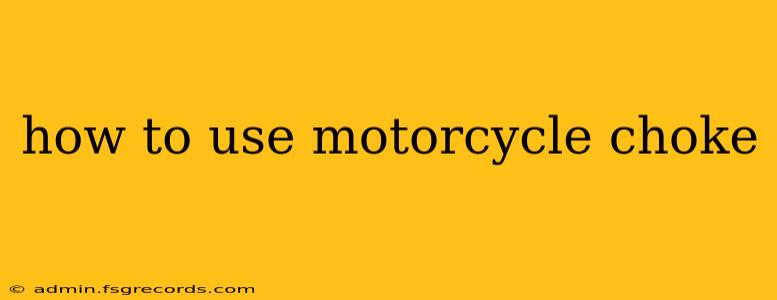Starting a motorcycle, especially in cold weather, can sometimes feel like a wrestling match. Understanding and properly using your motorcycle's choke is crucial for a smooth, reliable start every time. This guide will break down everything you need to know, from identifying your choke to mastering its use in various conditions.
What is a Motorcycle Choke?
A motorcycle choke enriches the fuel-to-air mixture entering the engine. Think of it as a temporary workaround for cold-starting issues. When the engine is cold, it struggles to ignite the lean fuel mixture delivered by the carburetor or fuel injection system. The choke restricts airflow, allowing a richer mixture—more fuel and less air—to enter the combustion chamber. This richer mixture burns more readily, enabling easier starting and smoother idling until the engine warms up.
Identifying Your Motorcycle Choke
Choke mechanisms vary depending on the motorcycle's age and type. Here are the common types:
1. Manual Choke Lever:
This is the most traditional type. It's usually a lever on the handlebar, often near the throttle. Pulling the lever fully engages the choke, partially pulling it offers a partial choke. You'll see these levers on older carburetted bikes.
2. Automatic Choke:
Modern fuel-injected motorcycles typically feature an automatic choke. These systems automatically adjust the air/fuel mixture based on engine temperature sensors. You won't have a manual lever to manipulate; the system manages it automatically.
3. Choke Cable (Carburettor Bikes):
On some carburetor bikes, the choke is controlled by a cable leading from a knob or lever to the carburetor. This will require engaging a knob or lever to choke the engine.
How to Use a Manual Choke
Using a manual choke is straightforward but requires a bit of practice:
-
Cold Engine: With a cold engine, pull the choke lever fully. This provides the richest fuel mixture for starting.
-
Starting the Engine: Attempt to start your motorcycle as usual.
-
Idling: Once the engine starts, it will likely idle roughly. This is normal. Keep the choke fully engaged for a few moments.
-
Gradually Reduce the Choke: As the engine warms up (typically after a minute or two), begin to gradually reduce the choke. Listen to the engine; if it starts to sputter or stall, add more choke.
-
Full Warm-Up: Once the engine runs smoothly at idle without the choke, you can release the lever entirely.
Important Note: Never leave the choke engaged once the engine is fully warmed up. This will cause the engine to run rich, leading to poor performance, excessive fuel consumption, and potentially damage to your catalytic converter (if applicable).
How to Use an Automatic Choke
Automatic chokes require minimal user intervention. Usually, when you turn the ignition key, the choke will engage automatically. The system will then automatically disengage it as the engine warms up. There's typically no need for you to manually control anything. If you experience starting problems, ensure the battery is fully charged. If it continues, consult your motorcycle's manual.
Troubleshooting Choke Issues
If your motorcycle is difficult to start even with the choke, consider these factors:
-
Old or stale fuel: Old gas can cause starting difficulties. Consider draining and replacing your fuel.
-
Clogged carburetor (Carburettor Bikes): A dirty carburetor can negatively impact fuel delivery. Cleaning or replacing it may be necessary.
-
Spark plug issues: A worn or fouled spark plug can prevent proper combustion. Check and replace it if necessary.
-
Battery issues: A weak battery won't provide sufficient power for starting. Charge or replace the battery if necessary.
-
Air filter: A clogged air filter will restrict air intake and negatively impact the air-fuel mixture. Regularly clean or replace this filter.
Conclusion
Mastering the use of your motorcycle's choke—whether manual or automatic—is a crucial skill for any rider. Understanding how it works and troubleshooting potential issues will ensure smooth starts and a better overall riding experience. Remember to always consult your owner's manual for specific instructions related to your motorcycle model.

